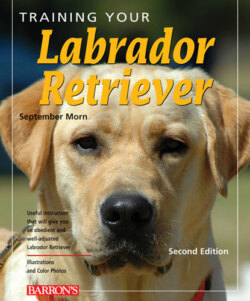Читать книгу Training Your Labrador Retriever - September Morn - Страница 12
На сайте Литреса книга снята с продажи.
Adolescent Dogs
ОглавлениеAt six months to a year a dog is not as cuddly as a little pup but may be a better pet choice for a busy household. The adolescent dog’s body and mind are well developed, and his physical needs are less urgent than a pup’s. At this age Buddy can tolerate four to six hours a day alone (in a puppy-proof area).
An adolescent Lab may already have learned decent manners and some have had formal training. Although an adolescent dog from a loving home may miss his former family at first, he will readily adapt to a new home when given affection and attention. In a few weeks, an adolescent dog can bond to a loving new family.
Labs that have formerly been neglected, or even abused, can recover with a caring and patient new owner. An underappreciated dog has probably heard his name used often in anger. You can help your new Lab forget his unhappy past by giving him a fresh start with a brand new name. Drop the old, tainted “bad dog” name and use the new name whenever you praise, play with, pet, or feed him. In a week or less, Buddy will respond proudly to his new name.
Your Lab needs the proper toys from puppy to adult.
Adolescent dogs have abundant energy and require lots of exercise to stay out of trouble. A walk around the block is not enough for a big young Lab; he also needs to run and play. Since the Lab’s heritage is to retrieve, fetch games are natural for exercise. If Buddy is sociable with other dogs, make play dates with his friends from obedience class or visit an off-leash park a few times a week so he can romp with other dogs.
Mental activity is also vital for a young dog, as bored adolescents can become destructive and unruly. Challenge Buddy’s mind with activities that make him think.
■ Enroll in obedience lessons and practice homework every day.
■ Teach tricks and games.
■ Join an Agility class or musical freestyle group.
■ Discover what interests Buddy and include that in his training as an activity and a reward; for example, keep interest high for a dog that likes to play catch by sometimes rewarding a good stay position by tossing him a ball.
Make sure your adolescent Lab has plenty of toys to gnaw when left alone. Since young Labs feel the need to exercise their growing teeth and jaws, they need plenty of interesting, satisfying chew toys to prevent damage to other objects such as walls, floors, furniture, and so on. Toys that hold and intermittently dispense food are excellent and can keep a dog occupied chewing for hours (see page 78). If you use two or three food-dispensing toys and vary their contents, Buddy’s interest in the toys will remain high.
Adopting a mature Lab can be very rewarding.
